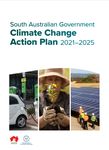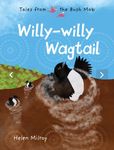Emergency Management February 2021 - Photo credit: Ethan Jones - State Emergency Service
←
→
Page content transcription
If your browser does not render page correctly, please read the page content below
Emergency Management
February 2021
SA GOVT CLIMATE CHANGE ACTION PLAN
2021-2025
The South Australian Government Climate Change Action Plan
2021–2025 will deliver the directions for a Climate Smart
South Australia, and drive further progress towards state-wide
goals of reducing greenhouse gas emissions by more than 50%
by 2030 and achieving net zero emissions by 2050.
By implementing the Action Plan, the government is expecting
to grow climate smart and low emissions industries, create new
jobs and attract additional investment, particularly to regional
areas.
The Action Plan describes 68 government-led actions
addressing key objectives in seven focus areas:
1. Clean energy transformation
2. Climate smart economy
3. Climate smart agriculture, landscapes and habitats
4. Low emissions transport
5. Climate smart built and urban environments
6. Resilient communities Photo credit: Ethan Jones
7. Government leading by example
Download a copy of the Action Plan here.
AFAC CLIMATE CHANGE
AND DISASTERS
The AFAC Climate Change and Disasters – Key Messages and Resources
document is designed to assist member agencies to continue to support their
communities to prepare for and adapt to the impacts of climate change. This
resource may also assist in preparing consistent communications and
messaging in response to media queries about climate change.
More information on climate and disaster risk is available hereFLOOD HAZARD MAPPING AND ASSESSMENT PROJECT
Martin Pullan, DIT
The Flood Hazard Mapping and Assessment Project approach that meets the objective of the Planning
seeks to ensure consistent and contemporary Flood and Design code of land use planning policy, enabling
the planning process to be quicker, simpler and more
Hazard mapping in South Australia to ensure, where
equitable.
possible, that future development can avoid the
impacts of flooding. It also aims to decrease the
Practice Guidelines and Directions related to the
likelihood of flooding for landowners whilst
Flooding Hazard Overlays will be prepared for the
supporting community resilience in developed areas
assessment of development applications, for
where flooding does occur.
consideration in regional planning and in preparing
amendments to overlays in the future.
Flood Data and Mapping Guidelines will be created
to ensure that any future flood studies or hazard The project seeks to enable flood study mapping and
modelling meets nationally defined benchmarks and data to be accessible to all stakeholders in a
standards and are fit for purpose, in determining centralised location facilitating data sharing and
coordination across jurisdictions and reducing costs
planning controls and providing flood intelligence
and duplication of resources across government.
products that can inform emergency response
planning.
A multi-agency team based in AGD - Planning and
Land Use Services will be undertaking this project in
These Guidelines will include considerations and
collaboration with staff from the Department for
projections on the impacts of climate change and
Environment and Water, Stormwater Management
future development e.g. urban infill. Existing flood Authority and Emergency Services agencies.
studies will be reviewed to ensure alignment with Consultation will occur in multiple stages with
national guidelines and best practice and, where councils, water industry and engineering consultants
practical, new studies or updates may be and other stakeholders.
undertaken for high risk areas.
This project will be completed in June 2022 at which
time an amendment to the Planning and Design Code
The Planning and Design Code Flood Hazard
would have commenced.
Overlays will be reviewed, and either updated or
replaced with a new spatial framework and policy
If you would like more information about this project, please contact
Martin Pullan on 7109 7030 / martin.pullan@sa.gov.au or Sally Jenkin on 7109 7038 / sally.jenkin@sa.gov.au.
Page 2WATER REPLENISHMENT GUIDELINES
In January 2021, The State Emergency Management Committee released the Coordinated Water
Replenishment Guideline for South Australia. The guideline is to facilitate streamlined water
replenishment to impacted communities after a large-scale event.
The Guideline outlines the coordination of the provision of one-off immediate water relief for those
directly impacted by a natural disaster. It provides initial water replenishment where property
owners/tenants have facilities to store the provided water (up to 9,000 litres). The water is for the health
and welfare of humans and animals (such as residential drinking purposes or immediate livestock drinking
or hygiene purposes).
The document defines how recovery coordination identify:
who requires water for immediate relief,
how the provision of water is funded, and
how it is distributed to those in need.
The Guideline requires that ZEMCs identify
regional-specific water replenishment issues.
COMMUNITY ENGAGEMENT FOR
DISASTER RESILIENCE HANDBOOK
The focus of the Community Engagement for Disaster
Resilience Handbook is the ongoing improvement of disaster
preparation, response and recovery and reflects the increasing
need to reduce disaster risk and build disaster resilience within
and across communities.
The handbook reflects approaches that are strengths-based
and inclusive and improve the quality and effectiveness of
community engagement practices. It is designed to maximise
inclusion and participation to achieve effective disaster
resilience outcomes.
The handbook is for use by practitioners working in the
government, non-government and private sectors, as well as
volunteers and community leaders and can be accessed in the
Australian Disaster Resilience Knowledge Hub.
Page 3Temperatures for February to April are likely
to be warmer than average around much of
the Australian Coastline.
Overnight temperatures for February to April
are likely to be above average across nearly
all of Australia.
La Nina remains active in the tropical Pacific.
The event has likely reached its peak strength
but is expected to continue to influence
Australian rainfall patterns until at least early
autumn.
THE UNEQUAL BURDEN OF DISASTERS IN
AUSTRALIA
While it is well known that the cost of disasters can often run in to the billions of dollars, research has
found that income losses is one area that is often not accounted for.
Those most likely affected included low-income earners, small business owners and part time workers. The
industries with the greatest losses were agriculture and accommodation and food services (includes
tourism industry).
For example, following the 2009 Black Saturday bushfires, agricultural employees who lived in the area
experienced an average of $8,000 drop in annual income for the next two years. Those employed in the
accommodation and food services industries lost an average of $5,000.
The gap between middle- and low-income earners was also
found to have widened by approximately $7,000 after the
2010-2011 Queensland floods.
To read more, including which demographics saw an increase
in income, see the Australian Journal of Emergency
Management (Oct 2020).
Page 4DISASTER
RESILIENCE Challenge 1:
INNOVATION The problem:
CHALLENGES
How can communities be motivated to plan
together to be sufficient and resilient for a
minimum of 3 days during a disaster?
Sue Gould, SAFECOM Students were from:
Heathfield Highschool, Adelaide Botanic and
Disaster Resilience Innovation Challenges
Darwin Middle School
for high schools were trialled in SA as an
Winner of Best Idea:
initiative aligned to Stronger Together:
Initiation of a National Disaster Day (like Japan’s
SA’s Disaster Resilience Strategy. The
Disaster Prevention day).
project was funded through the 2019-20
Commonwealth and State funded SA
Disaster Resilience Grants and delivered
by Incept Labs in partnership with
Challenge 2:
SAFECOM. Unfortunately, due to COVID-
The problem:
19, the Challenges planned for March How might agencies within the Emergency Services
2020 had to be rescheduled and sector collaborate to attract diverse, young adult
delivered online later in 2020, reducing volunteers in country communities?
the availability of some schools.
Students were from:
Scotch College and University Senior College
Best Idea:
The program involved high school
An Emergency Services Fair that would provide a
students identifying solutions to complex
platform for social media engagement, as well as
real-world resilience and emergency
experiential opportunities for community to engage
management problems, provided by the
with EM technologies.
sector. Students were supported through
a design thinking process to research the
problems, interview stakeholders and
pitch ideas assessed by sector experts. Challenge 3:
The problem
From a range of ideas from Emergency Develop a culturally inclusive evacuation process,
Management agencies, three problems that provides effective ways to assist international
students to evacuate safely.
were selected, which resulted in some
Students were from:
great collaboration and hard work to
Immanuel College and Eden Marine High School
prepare the context for the students. The
Best Idea:
students were mixed into across school
A mobile app that international students
groups and competed to present the best
download, can deal with multiple languages, and
idea, best pitch, and best group work.
provides for all elements of the evacuation
This produced some great ideas, learning, process. A prototype was developed.
and food for thought for agencies.
Page 5BUSHFIRE BOOKS FOR KIDS
After the NSW Rural Fire Service saved his home during the 2019-2020 Australian bushfires, Ted
Prior, realised that Grug would only survive a bushfire by being underground. He hopes his latest
book will help to spread a message of hope and preparedness.
Since these bushfires, several other Australian children’s authors have also recognised the need to
teach children about bushfires. For other books and more information, see the article in The
Guardian (12 Jan 2021).
DISASTER RESILIENCE
To stay up to date between editions of EM News, sign up for Neil Dufty’s This Week in Disaster
Resilience for a range of articles related to disaster resilience throughout Australia and the world.
Page 6You can also read



























































